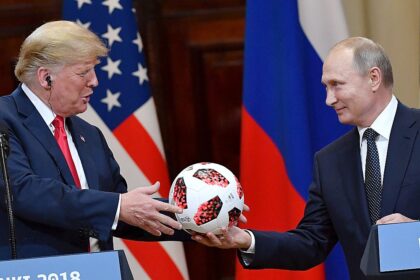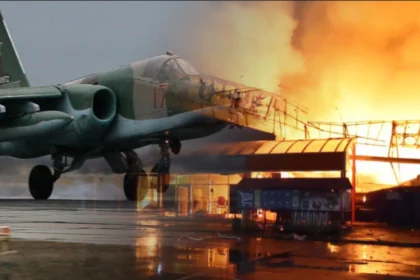During a recent visit to St. Petersburg, Russian President Vladimir Putin’s personal security team was spotted with what appears to be a newly developed FPV drone designed specifically for countering hostile unmanned aerial systems.
The presence of the drone, visibly carried by a member of the presidential protection unit, has drawn attention due to its unusual size and specialized configuration.
According to observers at the scene, one of the security officers accompanying Putin was seen carrying the drone close to the president. The officer reportedly attempted to obscure the system from public view, but the platform’s large frame and distinctive X-shaped layout made concealment difficult.
The drone, believed to be an infantry-operated FPV interceptor, features a four-motor cross configuration and a dual-sensor targeting system. Its payload includes a thermal imaging and television-guided seeker head, which allows it to engage aerial targets under low-visibility conditions, including poor weather and nighttime operations.
The system is manually directed in its initial targeting phase, but once a target is acquired, it reportedly shifts to autonomous flight. As described, the operator initiates the drone, aligns it toward the target, and waits for lock-on. Once the seeker confirms the target, the drone launches and autonomously tracks and engages the object.
Notably, the system is said to operate using a dedicated command and telemetry channel, rather than standard radio frequencies. This design reportedly prevents detection of the operator’s location by enemy electronic warfare or signals intelligence systems.
While there has been no official acknowledgment from the Russian Federal Protective Service (FSO), the sighting suggests that Moscow may be fielding short-range, soldier-carried drone interceptors as part of its close-protection toolkit—particularly in response to the growing threat of small UAVs used for surveillance or attacks in urban settings.
The emergence of this system near Putin also comes amid increasing concerns in the Russian security establishment about drone threats on domestic soil. Ukraine has repeatedly used FPV drones for tactical strikes deep inside Russian territory, including against infrastructure and military assets. The presence of a compact, portable counter-UAV platform directly in the hands of a presidential guard may reflect a shift toward more immediate and mobile defense solutions.
This is the first known instance of such a system being publicly associated with Russia’s top leadership protection units. Analysts say the presence of this technology may indicate that the Kremlin views the threat from airborne drones as immediate and credible—even in urban environments previously considered secure.











